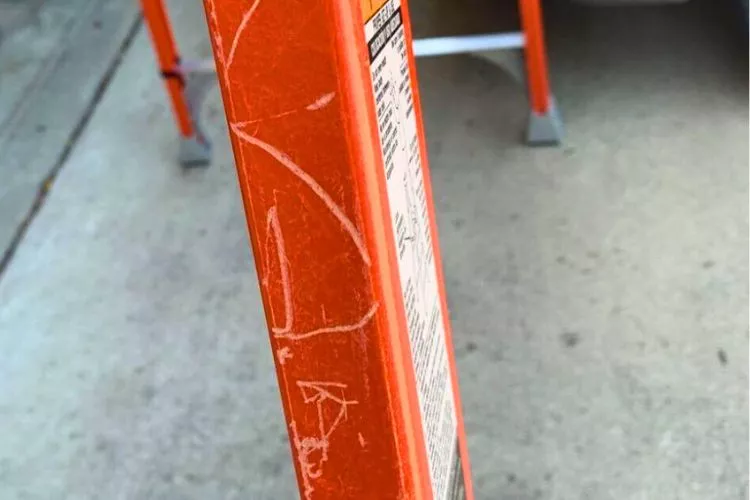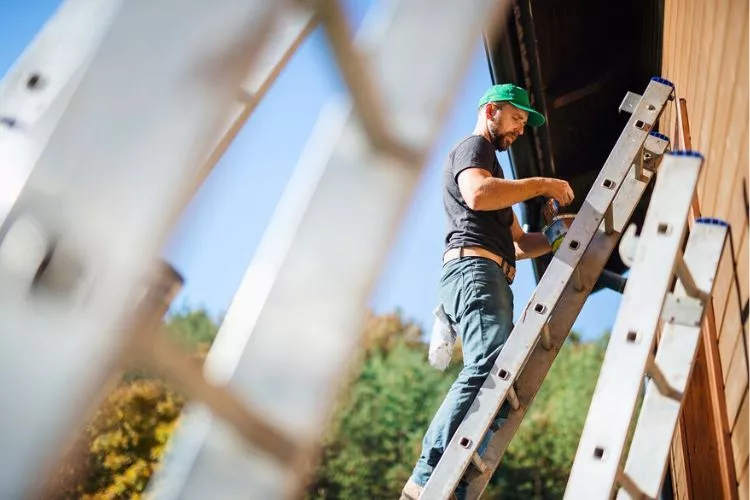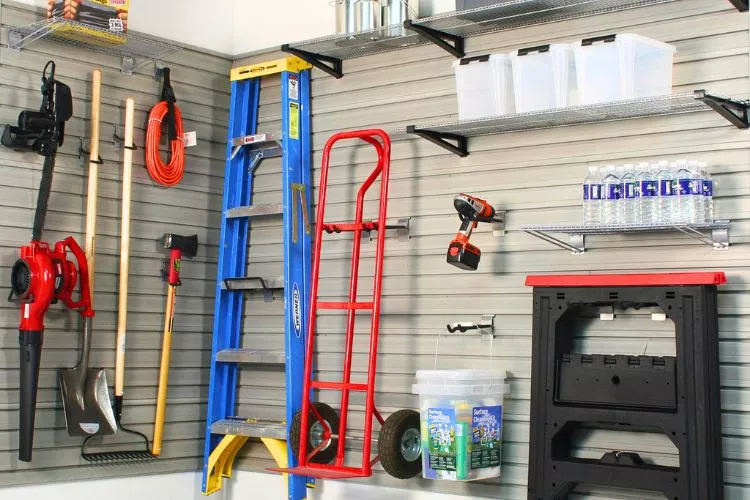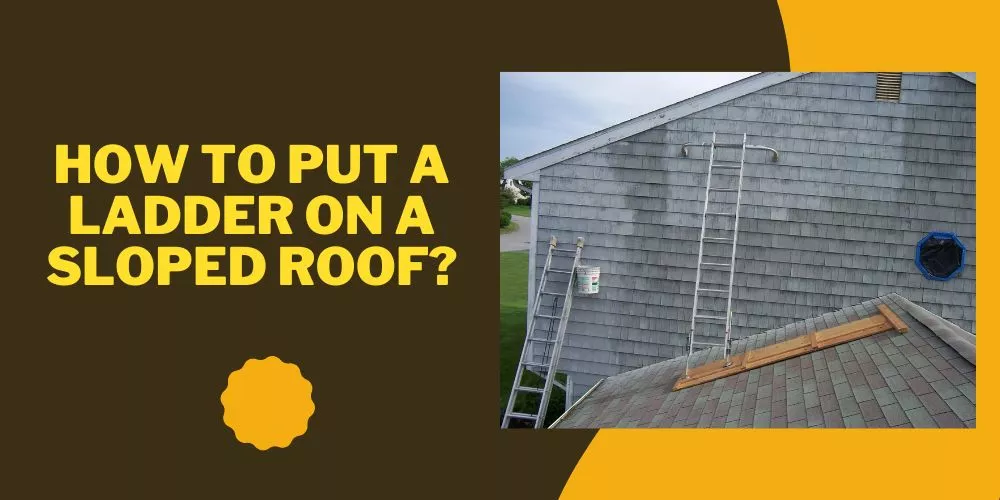Fiberglass ladders are a fantastic companion for DIY-enthusiasts, electricians, painters and homeowners alike due to their overall durability, non-conductive properties and extended lifespan.
However, they carry their peculiarities as well – one of the most common yet ignored being a shedding or flaking issue over time due to continual wear and tear or weathering.
That’s why it becomes important to learn how to stop a fiberglass ladder from shedding in an easy to understand manner.
Because, when these tiny fibers detach, they can cause discomfort, skin irritation, or even respiratory issues upon inhalation. Not to mention, they can transform a clean job site into a quite messy one pretty swiftly.
In this in-depth guide, we’ll explore how you can tackle this issue head-on and stop your fiberglass ladder from shedding, ensuring safety, cleanliness, and efficiency on your way towards completing any job.

How To Stop A Fiberglass Ladder From Shedding?
Fiberglass ladders are durable and reliable, but over time they can start to shed their composite fibers due to aging, rough handling or weather impact. Here’s a comprehensive guide on how to prevent a fiberglass ladder from shedding.
🪜 Understand the Problem
Before taking any preventative measures, it’s crucial to understand why fiberglass ladders shed. This typically happens due to regular wear and tear, poor quality material, or being frequently exposed to harsh weather. Once you pinpoint the cause, it’s easier to come up with the solution.
🪜 Regular Cleaning
One simple way to prevent ladders from shedding is by cleaning them regularly. Use warm soapy water and a soft brush to clean away any loose fibers. Remember to rinse thoroughly afterwards.
However, never use a pressure washer on your ladder as this can cause further damage.
🪜 Sanding the Surface
After thoroughly cleaning the ladder, the next recommended step is sanding. Use fine-grit sandpaper to lightly sand the surface of the ladder. This not only helps to remove the loose fibers but also smoothens the surface.
🪜 Applying a Sealant
Sealing is an efficient way to prevent your fiberglass ladder from shedding. Once sanded, apply a high-quality sealant with a brush all over the ladder. The sealant acts as a barrier that prevents the fiberglass from shedding its fibers.
🪜 Regular Inspections
Last but not least, regularly inspect your ladder. Look out for signs of wear and tear, fraying fibers, and cracks. If your ladder is already severely deteriorated, it may be best to invest in a new one for the sake of safety.
The shedding problem of a fiberglass ladder can be effectively curtailed by regular cleaning, sanding, applying a sealant, and consistent inspections. It’s essential to acknowledge that the longevity of your ladder greatly hinges on appropriate care and regular attention.
It not only ensures the durability of the ladder but also guarantees the safety of the user. With the correct maintenance measures in place, a fiberglass ladder can indeed remain a reliable and safe tool for numerous years.
Preventive Measures to Avoid Fiberglass Ladder Shedding in the Future
There are several strategies you can implement to help preserve your fiberglass ladder, preventing excessive wear and tear, and ultimately reducing the chances of shedding fiberglass fibers.
By prioritizing preventive measures, you can significantly extend the life and functionality of your ladder.

🪜 Proper Handling
One of the best ways to prevent early ladder degradation is by handling it carefully. This includes how you set up and dismantle your ladder, transport it, and even pass it off to others. Always avoid dragging your ladder across rough surfaces, as this can easily damage the fiberglass and cause it to shed.
🪜 Regular Maintenance
Frequent inspections and cleaning are key to maximizing the lifespan of your ladder. Clean your ladder regularly to get rid of any debris or dirt. Also, inspect for any visible damage such as cracks or loose fibers.
🪜 Storage
The way you store your ladder can also impact its longevity. After use, it should be stored properly – free from exposure to harsh elements like chemical substances, direct sunlight, or fluctuating temperatures. Store it in a cool, dry place, ideally hanging it horizontally on wall brackets.
🪜 Protect Against Overloading
Every ladder has a weight limit — usually identified by its duty rating. Exceeding this limit can cause premature deterioration, so only use a ladder within the prescribed weight limit.
🪜 Professional Repairs
If, during your regular inspections, you notice any serious damage or wear on the ladder, it may be prudent to take it to a professional repair center. They can correctly assess the level of damage, potentially repair it, and ensure more life from your ladder which a DIY fix might not guarantee.
By focusing on these preventive measures, users can maintain their fiberglass ladders in good shape, prevent unnecessary shredding, and ensure safer and more durable usage.
Proper Storage Techniques for Your Fiberglass Ladder
Ladders, especially ones made from fiberglass, require proper storage to prevent premature wear and tear. How you store your ladder can significantly impact its lifespan and functionality. Here are some proven techniques for storing your fiberglass ladder correctly.

- Clean Before Storing: Always clean your ladder before storing it. Remove any dirt, dust, or debris that’s collected on the rungs or sides. This leftover detritus can cause degradation over time, so it’s crucial to clean it regularly.
- Store Indoors: If possible, store your ladder in an indoor location, such as a garage, shed, or basement. Keeping your ladder indoors protects it from the elements and shields it from temperatures.
- Avoid Exposure to Sunlight: Prolonged exposure to direct sunlight can significantly damage your ladder by causing the fiberglass material to break down and shed fibers. A shaded location is best for storage.
- Keep Away from Chemicals: Some chemicals can corrode the ladder over time. Keep your ladder far from chemical storage areas to avoid accidental spillage or fume damage.
- Maintain Ventilation: While shielding your ladder from harmful elements, make sure the storage area has ample ventilation to prevent buildup of moisture, which can lead to ladder degradation over time.
- Proper Positioning: Ladders should ideally be stored horizontally on wall-mounted hooks or brackets. This method evenly distributes the weight of the ladder and helps prevent any warping or bowing. If horizontal storage isn’t an option, store your ladder vertically.
- Avoid Ground Contact: Keeping your fiberglass ladder off the ground helps prevent moisture absorption and keeps it from direct contact with dirt and debris.
By implementing these storage techniques, you can extend the lifespan of your fiberglass ladder considerably, helping to prevent unnecessary deterioration and ultimately make your ladder safer, more stable, and reliable for whenever you need it.
Conclusion:
Fiberglass ladders are trusted for their strength and reliability, they can degrade and shed over time if not cared for properly. Regular cleaning, careful handling, timely repairs, use of sealants, proper storage, and consistent safety inspections are vital to prevent this shedding.
With these measures in place, your fiberglass ladder can remain a reliable and safe tool for many years, ensuring efficient usability and substantial longevity.
The key lies in proactive maintenance rather than reacting once deterioration sets in. A well-maintained ladder doesn’t just perform better – it’s also safer.


